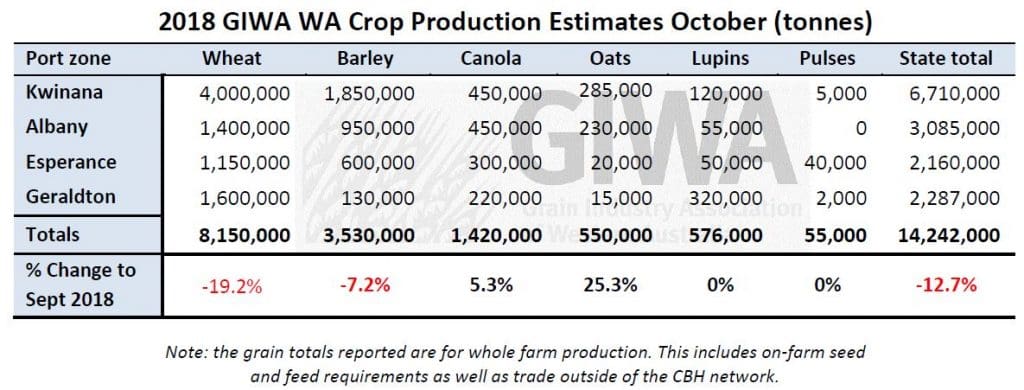
A wheat crop at Calingiri, northeast of Perth, which is estimated to yield 6 tonnes per hectare. (Photo: Jarrod Tonkin, Flexigrain)
WESTERN Australia’s winter crop continues to ride the roller coaster with savage frosts and the driest September in more than 80 years cruelling the prospect of a potential record crop, but rain over the weekend clawing back some of the losses.
In its October crop report released on Friday, the Grain Industry Association of Western Australia (GIWA) put the estimate for WA’s total winter crop at 14.242 million tonnes (Mt), down 12.7 per cent on the September estimate of 16.305Mt.
However, GIWA Oilseeds Council chair and report author, Michael Lamond, said widespread rain on the weekend had arrested the slide and might have even bumped up production potential to around 15Mt.
“We started getting storms about 10 days ago. That has put the brakes on the slide, but in a lot of areas the damage was already done,” he said.
“But we have had quite a bit of rain over the weekend. So, for the whole central area, Kwinana and Kwinana East in particular, there has been 10-20 millimetres on top of what they had already had.
“The north and the south all got rain, but most areas had less than 10mm, so it probably won’t have much impact in the Lakes area, but that, combined with cooler temperatures in the north, will kick yields there.
“It will really kick yields a lot in the central areas. I reckon we could easily be up 0.5 million tonnes just on the weekend rain. 15Mt is probably not out of the question now.”
Total wheat tonnage for WA is now expected to be greater than in 2017 but well down on what was expected a month ago.
Barley tonnage is expected to be similar to 2017 and significantly less, due to the frost events, than what could have been the case with the extra area planted in the state this year.
The WA canola area was down from 2017 due to the later start and combined with a difficult start for the crop and frost, total tonnage is expected to be nearly 400,000 tonnes less than last year.
Mr Lamond said it was hard to pick what final production figures would be for canola.
The estimate for October has been raised 5.3 per cent to 1.41MT.
“We pushed the canola area back too much (initially), based on the substitution of barley. The canola and lupins are really hanging on. Whilst everyone is still talking down canola, I reckon it could go up a bit as well,” he said.
The oats estimate has increased dramatically by 25.3pc – albeit off a low base – due to more growers opting to push their crops through to grain.
“With all the rain over the last two weeks, a lot of guys held off cutting their oats for hay. Where they have milling grade, the milling grade price is really good, and at the last minute they decided not to make hay and left it for milling grade.”
The lupin area is well up from 2017 due to the improved conditions in the north of the state. Tonnages are expected to be back up to recent levels.
The increase in pulse area this year has taken another hit from the frost, particularly for field peas, although lentils and faba beans have been less affected.
Source: GIWA, http://www.giwa.org.au/
Grain Central: Get our free daily cropping news straight to your inbox – Click here


HAVE YOUR SAY